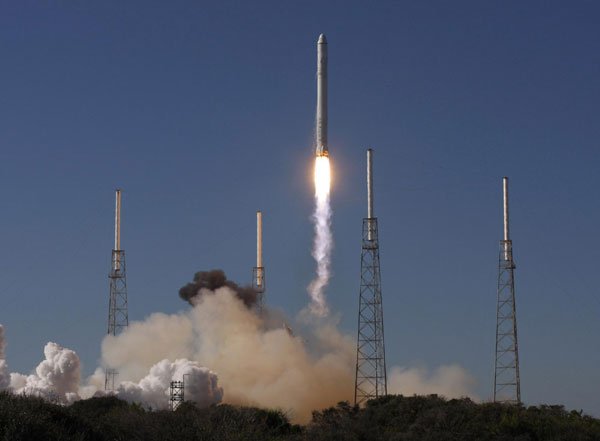Science and Health
Spacecraft splashes into Pacific on demo flight
(Agencies)
Updated: 2010-12-09 02:44
 |
Large Medium Small |
|
 Illustration and diagrams describing the Space X Dragon reusable spacecraft scheduled to be launched for an orbital test flight on Wednesday.[Photo/Agencies] |
The capsule named Dragon, built by Space Exploration Technologies Corp, splashed down into the Pacific Ocean three hours after launching from Cape Canaveral. NASA immediately offered congratulations.
"Splashdown on target. Mission is a success!" the company announced via Twitter.
Until now, only governments had accomplished re-entries from orbit.
The Dragon rode into orbit Wednesday morning aboard a SpaceX Falcon 9 rocket. It circled the world twice, then parachuted into the Pacific. It was aiming for a spot roughly 500 miles (805 kilometers) off the Mexican coast. Recovery crews were quickly on the scene, putting floats on the spacecraft.
The spacecraft carried thousands of patches for company employees; no official payload was required for this test.
NASA is hiring companies like SpaceX to haul supplies to the International Space Station following next year's retirement of the space shuttle. Taxi trips for astronauts may follow.
The flight had been scheduled for Tuesday, but was delayed to repair cracks in the upper-stage rocket nozzle.
This was the first flight under NASA's Commercial Orbital Transportation Services program, as well as the first flight of an operational Dragon spacecraft. SpaceX's first flight of a Falcon 9 rocket, in June, carried a capsule mock-up that deliberately burned up on re-entry.
The rocket stands 158 feet (48 meters) tall, about the height of the shuttle's external fuel tank.

SpaceX's Falcon 9 rocket with the Dragon capsule lifts off from launch complex 40 at the Cape Canaveral Air Force station in Cape Canaveral, Florida Dec 8, 2010. A privately owned company put the spacecraft into orbit on Wednesday in a test flight that NASA hopes will eventually lead to cargo runs to the International Space Station after its space shuttles are retired next year. [Photo/Agencies] |
"Getting this far, this fast, has been a remarkable achievement," said NASA's acting director of commercial spaceflight development, Phil McAlister. He stressed that this is a test flight and that spaceflight is "very, very difficult."
"The purpose of the test flight is to learn. So as long as we're learning, and we have a clear path for demonstration flight two, we would consider that successful," McAlister told reporters earlier this week.
The California-based SpaceX _ created by PayPal co-founder Elon Musk _ intends to begin station deliveries by the end of 2011. He said he could be launching station crews within three years of getting the go-ahead from NASA.
NASA already is relying on Russia to ferry US astronauts to and from the space station. It's an expensive arrangement: $26 million per person this year, rising to $51 million next year, and to $56 million in 2013.
Ideally, NASA wants multiple companies to take over the job of cargo and crew transport. The effort has taken on increased significance, McAlister said, since the working lifetime of the space station was extended to at least 2020.
SpaceX currently has a $1.6 billion contract with NASA for 12 supply runs. Orbital Sciences Corp. of Virginia has a $1.9 billion contract for eight.
SpaceX President Gwynne Shotwell said her company has poured more than $600 million into the test flight effort so far and received $278 million from NASA. She took aim at critics, some of whom don't trust companies to provide the same level of crew safety as NASA.
"I bristle a little bit at the whole concept of 'cutting corners,' " she said this week. "Just because it's faster doesn't mean it's more risky."
NASA has just two shuttle missions remaining, in February and April. The space agency hopes to get funding for a third and final flight next summer, to restock the orbiting lab in case the commercial launch companies fall behind.